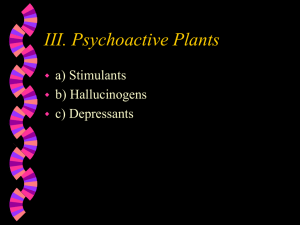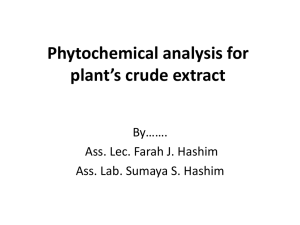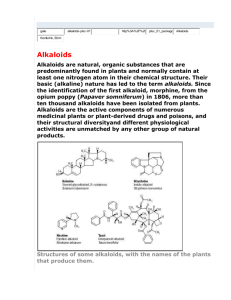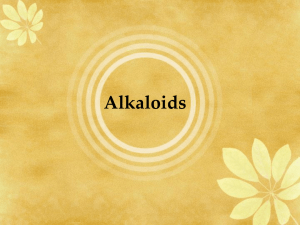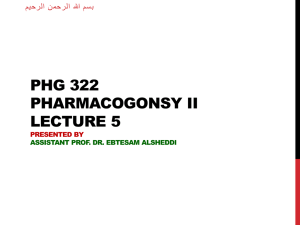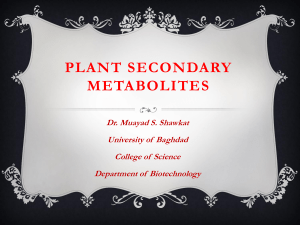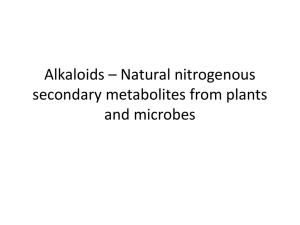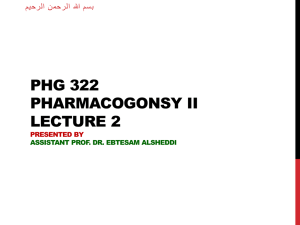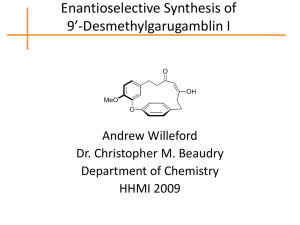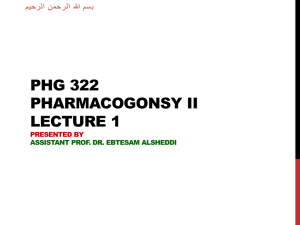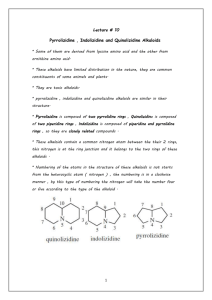Màster de Biotecnologia Molecular Oferta per a la realització del
advertisement
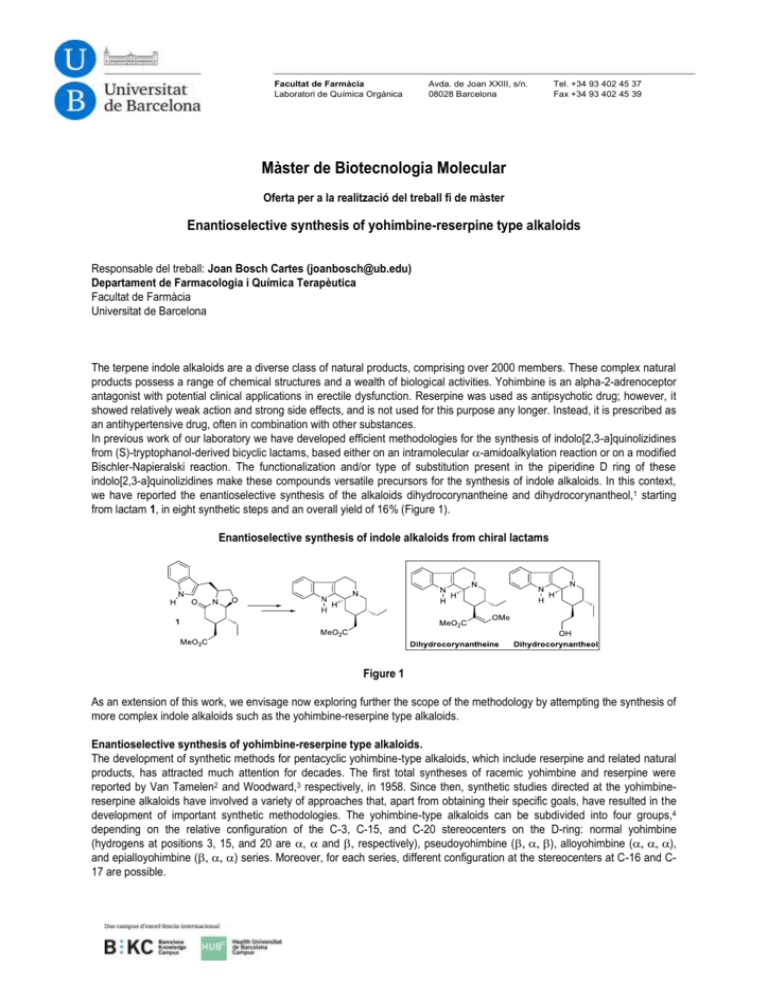
Facultat de Farmàcia Laboratori de Química Orgànica Avda. de Joan XXIII, s/n. 08028 Barcelona Tel. +34 93 402 45 37 Fax +34 93 402 45 39 Màster de Biotecnologia Molecular Oferta per a la realització del treball fi de màster Enantioselective synthesis of yohimbine-reserpine type alkaloids Responsable del treball: Joan Bosch Cartes (joanbosch@ub.edu) Departament de Farmacologia i Química Terapèutica Facultat de Farmàcia Universitat de Barcelona The terpene indole alkaloids are a diverse class of natural products, comprising over 2000 members. These complex natural products possess a range of chemical structures and a wealth of biological activities. Yohimbine is an alpha-2-adrenoceptor antagonist with potential clinical applications in erectile dysfunction. Reserpine was used as antipsychotic drug; however, it showed relatively weak action and strong side effects, and is not used for this purpose any longer. Instead, it is prescribed as an antihypertensive drug, often in combination with other substances. In previous work of our laboratory we have developed efficient methodologies for the synthesis of indolo[2,3-a]quinolizidines from (S)-tryptophanol-derived bicyclic lactams, based either on an intramolecular -amidoalkylation reaction or on a modified Bischler-Napieralski reaction. The functionalization and/or type of substitution present in the piperidine D ring of these indolo[2,3-a]quinolizidines make these compounds versatile precursors for the synthesis of indole alkaloids. In this context, we have reported the enantioselective synthesis of the alkaloids dihydrocorynantheine and dihydrocorynantheol,1 starting from lactam 1, in eight synthetic steps and an overall yield of 16% (Figure 1). Enantioselective synthesis of indole alkaloids from chiral lactams Figure 1 As an extension of this work, we envisage now exploring further the scope of the methodology by attempting the synthesis of more complex indole alkaloids such as the yohimbine-reserpine type alkaloids. Enantioselective synthesis of yohimbine-reserpine type alkaloids. The development of synthetic methods for pentacyclic yohimbine-type alkaloids, which include reserpine and related natural products, has attracted much attention for decades. The first total syntheses of racemic yohimbine and reserpine were reported by Van Tamelen2 and Woodward,3 respectively, in 1958. Since then, synthetic studies directed at the yohimbinereserpine alkaloids have involved a variety of approaches that, apart from obtaining their specific goals, have resulted in the development of important synthetic methodologies. The yohimbine-type alkaloids can be subdivided into four groups,4 depending on the relative configuration of the C-3, C-15, and C-20 stereocenters on the D-ring: normal yohimbine (hydrogens at positions 3, 15, and 20 are , and respectively), pseudoyohimbine (), alloyohimbine (), and epialloyohimbine () series. Moreover, for each series, different configuration at the stereocenters at C-16 and C17 are possible. Yohimbine-reserpine alkaloids Figure 2 In this context, we plan to develop a synthetic methodology for the enantioselective synthesis of yohimbine-type alkaloids 3 and synthetic analogs taking advantage of the easy availability of indolo[2,3-a]quinolizidine derivatives through the abovementioned procedure based on the use of (S)-tryptophanol-derived bicyclic lactams. In order to assemble the carbocyclic E ring of the yohimbane nucleus from tetracyclic unsaturated lactams 2 we have devised an expeditious procedure based on the use of Nazarov reagents (Figure 3).5 In this transformation, two carbon-carbon bonds would be formed (C-15/C-16 and C-19/C-20), with generation of two stereogenic centers (C-15 and C-20), in a one-pot reaction. Synthetic proposal Figure 3 Methyl or ethyl esters of 3-oxo-4-pentenoate (Nazarov's reagent, 4a) are well known reagents, extensively used for several annulation reactions such as the classical Robinson annulation. More recently, P. Deslongchamps has described the stereocontrolled reaction of cyclohexenones with a Nazarov reagent, known as anionic polycyclization, to give cis-decalinediones.6 The reaction consists of two successive Michael additions and the final result is analogous to a Diels-Alder cycloaddition. In all cases the reaction involves the use of a C-5 alkyl substituted Nazarov reagent 4b (R=alkyl), but there are no reported examples of the use of the Nazarov reagent 4a (R=H) in these polycyclizations. With the final goal of the synthesis of yohimbine-type compounds in mind, model studies on the annulation reaction from unsaturated derivatives of valerolactam 6 will be undertaken in order to explore the feasibility of this reaction. In these studies, the Nazarov reagent 4a and several alkyl substituted derivatives 4b will be used. If the unsubstituted compound 4a does not provide the expected results, silyl derivatives of the Nazarov reagent, such as 5, will be prepared and tested in this reaction.7 If good chemical yields and stereoselectivities are observed, we will also explore the organocatalytic version of the reaction using chiral urea or thiourea catalysts. Precedents and model studies Figure 4 Finally, the best scenario and conditions found in the above model studies will be applied to the reaction of indolo[2,3a]quinolizidine unsaturated lactams 8 with Nazarov reagents. In this case, at least two diastereomers 9a and/or 9b could be formed depending on the facial approach of the Nazarov reagent to the electrophilic carbon-carbon double bond of the unsaturated lactam 8. If good stereoselectivities are observed, the resulting compounds 9 will be transformed into yohimbinetype alkaloids 10. This conversion will require the removal of the hydroxymethyl and EWG substituents and the chemoselective reduction of the lactam and ketone functions. Enantioselective synthesis of yohimbine-type alkaloids Figure 5 References 1. Amat, M.; Gómez-Esqué, A.; Escolano, C.; Santos, M. M. M.; Molins, E.; Bosch, J. J. Org. Chem. 2009, 74, 1205-1211. 2. a) van Tamelen, E.; Shamma, M.; Burgstahler, A.; Wolinsky, J.; Tamm, R.; Aldrich, P. J. Am. Chem. Soc. 1958, 80, 50065007; b) van Tamalen, E.; Shamma, M.; Burgstahler, A.; Wolinsky, J.; Tamm, R.; Aldrich, P. J. Am. Chem. Soc. 1969, 91, 7315-7333. 3. Woodward, R. B.; Bader, F. E.; Bickel, H.; Kierstead, R. W. Tetrahedron 1958, 2, 1-57. 4. a) Indoles. The Monoterpenoid Indole Alkaloids; Saxton, J. E., Ed.; The Chemistry of Heterocyclic Compounds; Weissberger, A., Taylor, E. C., Eds.; Wiley: New York, 1983; Vol. 25, Part 4; b) Monoterpenoid Indole Alkaloids; Saxton, J. E., Ed.; The Chemistry of Heterocyclic Compounds; Taylor, E. C., Ed.; Wiley: Chichester, 1994; Supplement to Vol. 25, Part 4. See also: c) Leonard, J. Nat. Prod. Rep. 1999, 16, 319-338; d) Borschberg, H.-J. Curr. Org. Chem. 2005, 9, 1465-1491; e) Edwankar, C. R.; Edwankar, R. V.; Namjoshi, O. A.; Rallapalli, S. K.; Yang, J.; Cook, J. M. Curr. Opin. Drug Discov. Devel. 2009, 12, 752771. 5. Benetti, S.; Carli, S.; De Risi, C.; Pollini, G. P.; Veronese, A. C.; Zanirato, V. Synlett 2008, 2609-2612, and references cited therein. 6. a) Zhang, H.; Reddy, M. S.; Phoenix, S.; Deslongchamps, P. Angew. Chem. Int. Ed. 2008, 47, 1272-1275, and references cited therein; b) Reddy, M. S.; Zhang, H.; Phoenix, S.; Deslongchamps, P. Chem. Asian J. 2009, 4, 725-741; c) Caron, P.-Y.; Deslongchamps, P. Org. Lett. 2010, 12, 508-511. See also: d) Tricotet, T.; Brückner, R. Tetrahedron Lett. 2006, 47, 84998502; e) Tricotet, T.; Brückner, R. Eur. J. Org. Chem. 2007, 1069-1074; f) Hampel, T.; Brückner, R. Org. Lett. 2009, 11, 48424845. 7. For the preparation and uses of 3-trimethylsilyl-3-buten-2-one, see: Organic Syntheses, John Wiley & Sons, Inc., Ed.; New York, 1978; Vol. 58, p. 152-157.

